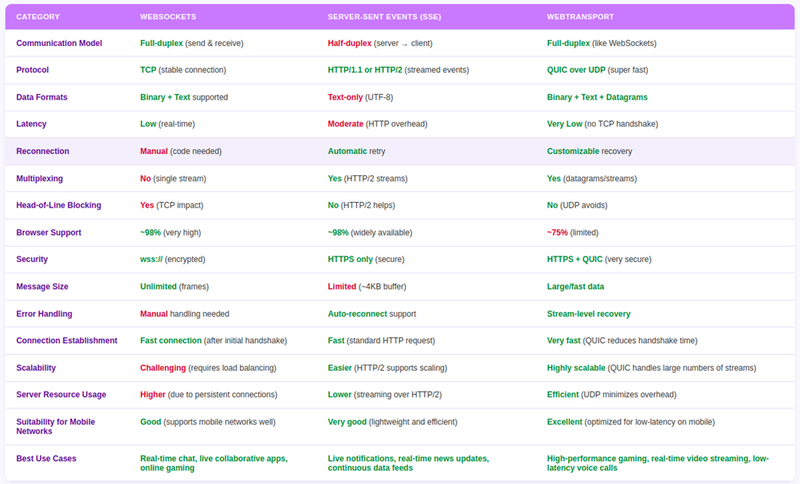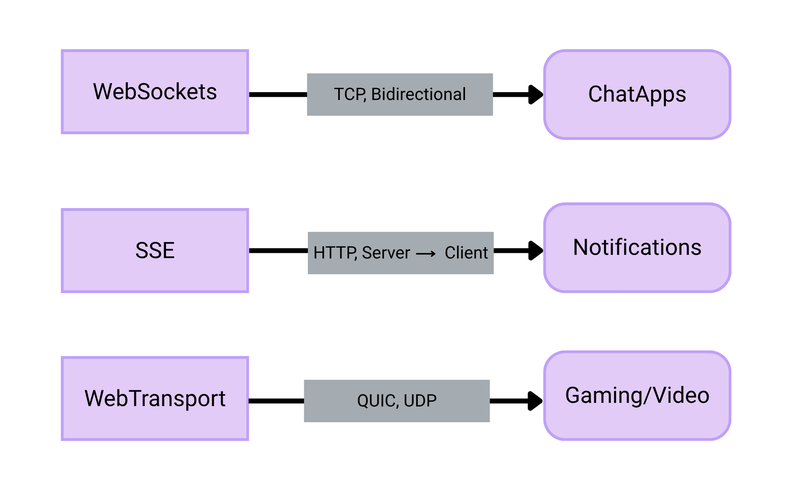In today’s digital world, users expect instant updates, seamless collaboration, and real-time interactivity — whether they're chatting with friends, tracking stock prices, or watching live sports scores. To make this possible, developers rely on real-time communication protocols that go beyond the traditional request-response model of HTTP.
Three major players in this space are:
- WebSocket – the go-to for full-duplex communication
- SSE (Server-Sent Events) – a simpler choice for one-way server pushes
- WebTransport – the new-gen protocol built on HTTP/3 and QUIC for speed and flexibility
But which one should you choose? In this post, we’ll break down how these protocols work, compare their strengths and weaknesses, and help you pick the right tool based on your application’s needs — whether you’re building a chat app, dashboard, or multiplayer game.
Let’s dive into the world of real-time web communication.
Overview of each Technology:
1.Websocket: Two-Way Real-Time Communication
What is it?
Imagine a phone call between two people. Once connected, both can talk and listen at the same time without hanging up. WebSockets work similarly—they allow a web browser and a server to have a continuous, two-way conversation.
websocket is a full-duplex, low-latency, stateful protocol exchanges change data between client and server. when a connection is initiated between a client and a server both will make handshake which means both parties decide to make a new connection to exchange data.Unlike traditional HTTP, which closes the connection after each request, WebSocket maintains a long-lived connection, enabling instant data transfer without repeated handshakes.
Key Characteristics:
1. Full-Duplex
- Both client and server can send and receive data simultaneously (like a phone call).
- Unlike HTTP, where the client must request data each time.
2. Low Latency
- Once the connection is established, data travels instantly without HTTP overhead.
- Ideal for real-time applications (chat, gaming, live updates).
3. Stateful
- The connection stays open until explicitly closed by either the client or server.
- No need to re-establish the connection repeatedly.
4. Persistent Connection
- Uses a single TCP connection for the entire session.
- Avoids the inefficiency of opening/closing connections (like in HTTP).
2. Server Sent Events(SSE): One-Way Live Updates
What is it?
Server-Sent Events (SSE) is a server-to-client communication protocol that allows a web server to push real-time updates to the browser over a single HTTP connection. Unlike WebSockets, SSE is unidirectional (server → client only).
Server side event is a uni-directional protocol which allows server to push real times updateds to the client.Like many other “data streaming approaches” for the web, SSEs establish a long-lived HTTP connection between the server and the client. Once the connection is established, the server can send data to the client anytime without requiring the client to make additional requests. This contrasts traditional HTTP connections, where the client must continuously poll the server for updates. SSEs provide servers with one of many approaches to real-time data pushing to clients.The server sends the events as a continuous stream, separated by newlines. Each event is preceded by an "event" field, which specifies the type of the event. It can also include fields like "data" to provide additional information. The events are sent in the following format:
data: eventData
data: eventData
Key Characteristics:
1. Unidirectional Communication
- Data flows only from server to client
- Client cannot send data back through SSE (requires separate HTTP requests)
2. HTTP-Based Protocol
- Uses standard HTTP/HTTPS (no special protocol)
- No need for connection upgrades like WebSocket
3. Text-Only Data Format
- Supports UTF-8 text data (no binary support)
- Common formats: Plain text, JSON, XML
4. Automatic Reconnection
- Built-in reconnection mechanism
- If connection drops, browser automatically reconnects
5. Event Stream Format
- Data is sent as a continuous stream with special formatting:
event: message
data: {"time": "12:00", "text": "Hello"}
id: 42
Simple Implementation
- Easy to set up on both client and server
- Uses standard web technologies (no special libraries needed)
Efficient for Many Connections
- Works well with HTTP/2 multiplexing
- Lightweight compared to WebSockets
3. Webtransport: The Future of Fast Data
What is it?
WebTransport is like WebSockets 2.0, but built on QUIC (a new internet protocol). It’s designed for ultra-fast, low-latency communication, especially for gaming and video.
Why Was WebTransport Created?
- Older technologies (like WebSockets) have limitations (e.g., delays when networks are unstable).
- Modern apps (games, video calls, live feeds) need lower latency and better performance.
- WebTransport uses HTTP/3 and QUIC, which are next-gen internet protocols built for speed.
WebTransport is a next-generation, low-latency, client-server communication protocol built on top of HTTP/3 and QUIC, supporting bi-directional, multiplexed, and secure data streams and datagrams.It's intended to replace or supplement existing technologies like long pulling, WebSockets, XMLHttpRequest, and Fetch. WebTransport networking tech is being developed to address the limitations of older technologies and to better support use cases like multiplayer gaming, real-time collaboration, and other applications requiring high-performance communication.WebTransport introduces new transport layer protocol the QUIC transport protocol specifically designed for real-time apps. This protocol provides several advantages over traditional protocols like TCP.
One of the key benefits of WebTransport is its improved scalability. The QUIC protocol allows for multiplexing, meaning multiple data streams can be sent over a single connection. This eliminates the overhead of establishing multiple connections, reducing latency and improving software efficiency.
WebTransport also offers enhanced security features with security mechanisms of QUIC, including encryption and authentication. Provides high confidentiality and integrity of data transmitted between clients and servers. This helps protect against common security threats, such as eavesdropping and tampering.
The WebTransport API offers crucial features like flow control, prioritization, and reliable delivery, enabling developers to enhance performance and user experience in real-time apps.
Key Characteristics:
1. QUIC Protocol Based
- Built on HTTP/3 and UDP (instead of TCP)
- Inherits QUIC's benefits: faster handshake, improved congestion control
2. Bidirectional Communication
- Full-duplex channels (like WebSockets)
- Both client and server can send data simultaneously
3. Multiple Data Transfer Modes
- Reliable streams (ordered, error-checked - like WebSockets)
- Unreliable datagrams (unordered, loss-tolerant - like UDP)
- Unidirectional streams (server→client or client→server)
4. Native Support for Multiplexing
- Multiple independent streams over one connection
- No head-of-line blocking (unlike TCP-based WebSockets)
5. Improved Mobility Support
- Better handling of network changes (Wi-Fi to cellular)
- Connection migration without session interruption
6. Enhanced Security
- Always encrypted (like HTTPS)
- Uses QUIC's built-in TLS 1.3
7. Designed for Performance
- Lower latency than WebSockets
- Better throughput for real-time media
8. Blazing Fast
- Uses QUIC protocol (designed for real-time apps)
- Lower latency than TCP-based connections
- Works well even on unstable networks
9. Smart Data Handling
- Prioritizes important data (like voice chat over game cosmetics)
- Can choose between "must arrive" (reliable) and "fast but optional" (unreliable) delivery
Comparison Table:

Real-Time Web Protocols:

Protocol Latency Scale:

When to Use Which?
Choosing Between WebSockets, SSE, and WebTransport
Each protocol excels in specific scenarios, and the best choice depends on your application’s data flow, latency requirements, and browser support. Here’s a quick guide to help you decide:
Websockets:
Chat Applications (WhatsApp, Slack, Discord)
- Needs instant two-way messaging (user to user)
- Handles high-frequency small packets efficiently
- Persistent connection avoids HTTP overhead
Live Multiplayer Gaming (Roblox, Agar.io)
- Requires millisecond updates (player positions, actions)
- Binary data support for game state transfers
- Lower latency than HTTP polling
Financial Dashboards (Stock Trading Platforms)
- Real-time price ticks (no refresh delays)
- Handles rapid sequential updates (order books, charts)
- More efficient than SSE for bid/ask streams
Collaboration Tools (Google Docs, Figma, Miro)
- Synchronizes edits across users instantly
- Merges well with Operational Transforms (OT)
- Better than HTTP for cursor position updates
Server Sent Events:
Live Notifications (Twitter alerts, Facebook updates)
- Simple server→client push (no client replies needed)
- Built-in reconnection → Survives network drops
- Lightweight for text-based alerts
Real-Time Dashboards (Stock tickers, sports scores)
- Efficient for read-only streams (1 connection per user)
- HTTP/2 multiplexing scales well
- No WebSocket complexity for one-way data
Progress Trackers (File uploads, CI/CD pipelines)
- Automatic retries if interrupted
- Easy to implement with backend APIs
News Feeds (Live blogs, election results)
- Native browser support (EventSource)
- Fits traditional HTTP infrastructure
Webtransport:
Cloud Gaming (Google Stadia, Xbox Cloud)
- UDP’s low latency→ Critical for input responsiveness
- Unreliable datagrams drop stale frames
Video Conferencing (Zoom, Meet alternatives)
- QUIC handles network switches seamlessly
- Mixes reliable (chat) + unreliable (video) streams
IoT Command Streams (Smart home controls)
- Survives flaky connections (mobile → IoT hub)
- Smaller overhead than WebSockets
High-Frequency Trading (Order book updates)
- Avoids TCP head-of-line blocking
- Sub-millisecond advantage over WebSockets
When You Might Not Need It
- Simple websites (regular HTTP is fine)
- Apps needing wide browser support (still new)
- Basic chat apps (WebSockets work fine)
- WebTransport is the future of real-time web apps, especially for performance-critical uses. While it won't replace WebSockets overnight, it solves many problems developers face with older technologies.
Future Consideration:
As WebTransport gains browser support, it may replace WebSockets for performance-critical applications. However, SSE remains the simplest choice for one-way updates, while WebSockets still dominate general real-time use cases.

